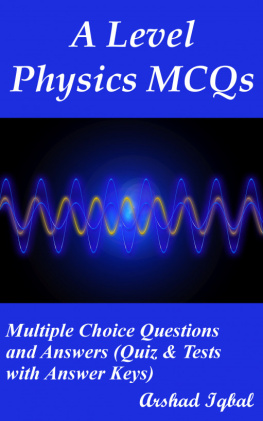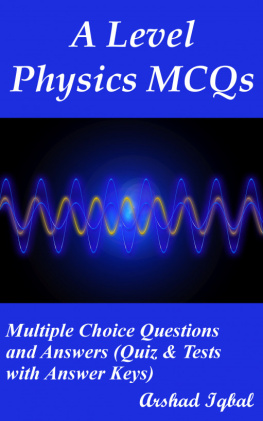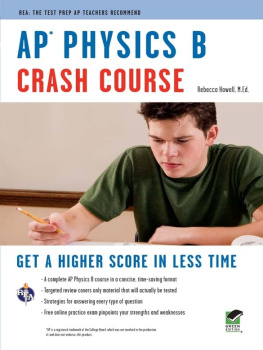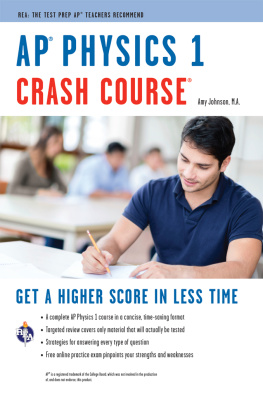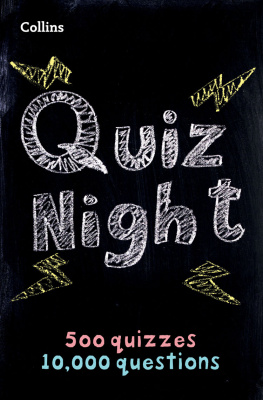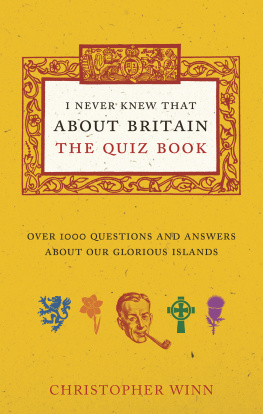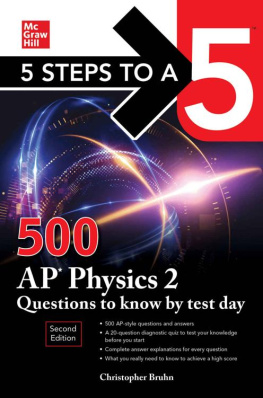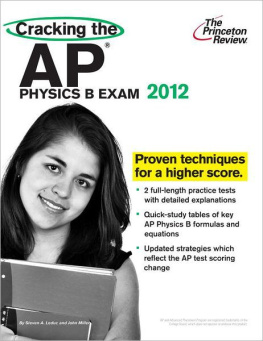A Level Physics MCQs
Multiple Choice Questions and Answers (Quiz& Tests with Answer Keys)
By Arshad Iqbal
Table of Contents
Chapter 2: Chapter 3: Chapter 4: Chapter 5: Chapter 6: Chapter 7: Chapter 8: Chapter 9: Chapter 10: Chapter 11: Chapter 12: Chapter 13: Chapter 14: Chapter 15: Chapter 16: Chapter 17: Chapter 18: Chapter 19: Chapter 20: Chapter 21: Chapter 22: Chapter 23: Chapter 24: Chapter 25: Chapter 26: Chapter 27: Chapter 28: Chapter 29: Chapter 30: Chapter 31: Chapter 32:
Chapter 1
Accelerated Motion MCQs
MCQ 1: Only force acting on abouncing ball is A. gravity B. weight of ball C. friction D. a and b both
MCQ 2: Accelerometer detectsthe A. large acceleration C. small deceleration D. large acceleration anddeceleration
MCQ 3: If the gradient of agraph is negative, then the acceleration is A. positive B. negative C. zero D. 1
MCQ 4: If a student drops astone from a cliff of height 30 m and the time it takes to reachthe ground is 2.6 s, then the acceleration due to gravity is A. 9 m s -2 B. 10 m s -2 C. 4 m s -2 D. 8.8 m s -2
MCQ 5: Gradient of line ofvelocity-time graph is tells us the A. velocity B. acceleration C. distance D. time
MCQ 6: A stone is thrown upwardswith initial velocity of 20 m s -1 , the height that stone will reach would be A. 20 m B. 30 m C. 40 m D. 50 m
MCQ 7: Projectile will attainits maximum range, if it is fired at an angle of A. 30 B. 47 C. 90 D. 45
MCQ 8: Horizontal component of abouncing ball is A. affected by gravity B. unaffected by gravity C. affected by weight D. affected by contact force
MCQ 9: When ball having aprojectile motion is rising up, it A. decelerates B. accelerates C. rises up with constantacceleration D. acceleration becomes zero
MCQ 10: Equation of motion canbe used for A. straight line motion only B. curved motion only C. motion along the circular path D. all types of motion
MCQ 11: Acceleration of freefall depends on the A. surface B. weight of object C. distance from center of Earth D. size of object
MCQ 12: If initial velocity ofan object is zero, then distance covered by it in time t andacceleration of 9.8 m s -2 wouldbe A. 2.9 t B. 3 t C. 4 t D. 4.9 t
MCQ 13: As the ball fallstowards the ground, its velocity A. increases B. decreases C. remains constant D. becomes zero
MCQ 14: Gradient ofvelocity-time graph tells us about object's A. velocity B. displacement C. distance D. acceleration
MCQ 15: An object whose velocityis changing is said to be in a state of A. acceleration B. rest C. equilibrium D. equilibrium D.
Brownian motion MCQ 16: Acceleration of trainwhen it is moving steadily from 4.0 m s -1 to 20 m s -1 in 100 s is A. 1 m s -2 B. 2 m s -2 C. 0.16 m s -2 D. 3 m s -2 MCQ 17: If we get a straightline with positive slope then its acceleration is A. decreasing C. zero D. constant MCQ 18: If a spinster staringfrom rest has acceleration of 5 m s -2 during 1st 2.0 s of race then her velocityafter 2 s is A. 20 m s -1 B. 10 m s -1 C. 15 m s -1 D. 5 m s -1 MCQ 19: Horizontal distancetravelled by a ball if it's thrown with initial velocity of 20 ms -1 at an angle of 30 is A. 24 m B. 56 m C. 35.3 m D. 36.3 m MCQ 20: If a car starting fromrest reaches a velocity of 18 m s -1 after 6.0 s then its acceleration is A. 1 m s -2 B. 2 m s -2 C. 3 m s -2 D. 4 m s -2 MCQ 21: A train travelling at 20m s -1 accelerates at 0.5 ms -2 for 30 s, the distancetravelled by train is A. 825 m B. 700 m C. 650 m D. 600 m MCQ 22: Area under velocity-timegraph tells us the A. time B. acceleration C. displacement D. velocity Answers Key: 1. D 2. D 3. B 4. D 5. B 6. A 7. D 8. B 9. A 10. A 11. B 12. D 13. A 14. D 15. A 16. C 17. D 18. B 19. C 20. C 21. A 22. C
Chapter 2
Alternating Current MCQs
MCQ 1: If a secondary coil has40 turns, and, a primary coil with 20 turns is charged with 50 V ofpotential difference, then the potential difference in thesecondary coil would be A. 50 V in secondary coil B. 25 V in secondary coil C. 60 V in secondary coil D. 100 V in secondary coil
MCQ 2: Generators at a powerstation produce electric power at voltage A. 45 kW B. 50 kW C. 60 kW D. 25 kW
MCQ 3: Equation which measuresalternating voltage is A. Vsin B. sin t C. sin t C.
V o sint D. V=IR MCQ 4: In transformer,alternating current is induced in A. primary coil B. secondary coil C. iron core D. less power loss B. more power loss C. high current D. high resistance MCQ 6: Graph of alternatingcurrent is a A. cos wave B. tan wave C. curve D. sine wave MCQ 7: A component that allowsonly unidirectional current to pass through it is A. resistor B. inductor C. transformer D. diode MCQ 8: Average power dissipatedin resistor if sinusoidal p.d of peak value 25 V is connectedacross a 20 resistor is A. 15.6 W B. 15 W C. 16 W D. 17 W MCQ 9: Amount of d.c voltage ascompare to V o is A. 50% B. 60% C. 70% D. 80% MCQ 10: A well designedtransformer loses power under A. 10% B. 1.20% C. 0.1% D. 20% MCQ 11: Ratio of voltages isequal to ratio of A. iron sheets in core B. coil C. number of turns in coil D. all of above MCQ 12: Process in which A.C isconverted into D.C is called A. induction B. rectification C. inversion D. dispersion MCQ 13: Steady d.c voltage isalso known as A. square velocity B. root mean square velocity C. root velocity D. velocity MCQ 14: Ratio of voltages isinverse ratio of the A. transformer B. resistor C. iron core D. current MCQ 15: If output voltage isgreater than input voltage, then transformer is A. step up B. step down C. faulty D. fatal MCQ 16: Highest point on ACgraph is known as A. peak value B. amplitude C. frequency D. wave front Answers Key: 1. D 2. D 3. C 4. B 5. A 6. D 7. D 8. A 9. C 10. C 11. C 12. B 13. B 14. D 15. A 16. A
Chapter 3
AS Level Physics MCQs
MCQ 1: There are three equationsof uniformly accelerated motion, the odd one out is A. final_velocity = initial_velocity +(acceleration time) B. distance_moved = (initial_velocity time) + (0.5 acceleration time) C. final_velocity = initial_velocity +(2 acceleration distance_moved) D. final_velocity = initial_velocity + (2 acceleration distance_moved)
MCQ 2: Kinetic friction isalways A. lesser than static friction B. greater than static friction C. equal to static friction D. equal to contact force
MCQ 3: Gravitational potentialis always A. positive B. negative C. zero D. infinity
MCQ 4: In order to keep a bodymoving in a circle, there exists a force on it that is directedtoward the center of the circle. infinity
MCQ 4: In order to keep a bodymoving in a circle, there exists a force on it that is directedtoward the center of the circle.
This force is known as A. Centrifugal force B. Centripetal force C. Gravitational Force D. magnetic force MCQ 5: A rectangle-shapedopen-to-sky tank of water has a length of 2 m and a width of 1 m.If the atmospheric pressure is assumed to be 100 kPa and thicknessof the tank walls is assumed to be negligible, the force exerted bythe atmosphere on the surface of water is A. 50 kN C. 100 kN D. 200 kN MCQ 6: If we have a positive anda negative charge, then force between them is A. positive B. negative C. zero D. infinite MCQ 7: Electrical force exertedby two point charges on each other is inversely proportional to A. sum of their charges B. product of their charges C. distance between them D. square of distance between them

